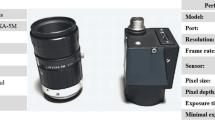Abstract
Surface texture is one of the important properties for the human to identify objects by touch. Effective reconstructions of textures are necessary for realistic interactions between the human and environment via human–computer interfaces. This paper presents a systematic approach for sensing and reconstructing periodic surface textures. Three significant issues are discussed: a pen-type texture sensor that measures the spatial information based on the measurements of contact forces; an algorithm for the reconstruction of periodic textures based on the obtained spatial information; and the method of incremental scanning to identify the polar spectrum of a surface by limited number of scans. The concept of polar spectrum is introduced to describe the spatial properties of the surface, that is, the relation between spatial frequencies and the direction of measurement. The pattern of polar spectrum is used to facilitate surface reconstructions. Experimental results based on the spatial information obtained with a laser displacement sensor and the pen-type texture sensor demonstrate the effectiveness of the proposed methods for the measurement and reconstruction of periodic textures.
Similar content being viewed by others
Explore related subjects
Discover the latest articles and news from researchers in related subjects, suggested using machine learning.References
Adi W, Sulaiman S (2009) Texture classification using wavelet extraction: an approach to haptic texture searching. In: Proceedings of innovative technologies in intelligent systems and industrial applications CITISIA 2009, pp. 434–439, July 25–26, 2009
Basdogan C, Ho C, Srinivasan MA (1997) A ray-based haptic rendering technique for displaying shape and texture of 3d objects in virtual environments. In: Proceedings of the ASME Dynamic Systems and Control Division 61:77–84
Choi S, Tan HZ (2004) Toward realistic haptic rendering of surface textures. IEEE Comput Graph Appl 24(2): 40–47
Fend M, Bovet S, Yokoi H, Pfeifer R (2003) An active artificial whisker array for texture discrimination. In: Proceedings of the IEEE/RSJ international conference on intelligent robots and systems (IROS 2003), vol 2, pp 1044–1049
Fritz JP, Barner KE (1996) Stochastic models for haptic texture. In: SPIE’s international symposium on intelligent systems and advanced manufacturing—telemanipulator and telepresence technologies, vol III, pp 34–44
Gray A, Abbena E, Salamon S (2006) Modern differential geometry of curves and surfaces with mathematica. Chapman & Hall/CRC, London
Hoop TH (1994) The sensitivity of three-point circle fitting. Technical Report NISTIR 5501, National Institute of Standards and Technology, Gaithersburg, MD
Hosoda K, Tada Y, Asada M (2006) Anthropomorphic robotic soft ngertip with randomly distributed receptors. Robotics Auton Syst 54: 104–109
Jia Y-B, Mi L, Tian J (2006) Surface patch reconstruction via curve sampling. In: Proceedings of the IEEE international conference on robotics and automation ICRA 2006, pp 1371–1377
Kim S-C, Kyung K-U, Sohn J-H, Kwon D-S (2006) An evaluation of human sensibility on perceived texture under variation of vibrotactile stimuli using a tactile display system. In: Proceedings of the 14th symposium on haptic interfaces for virtual environment and teleoperator systems, pp 429–436, March 25–26
Mayol-Cuevas WW, Juarez-Guerrero J, Munoz-Gutierrez S (1998) A first approach to tactile texture recognition. In: Proceedings of the IEEE international conference on systems, man, and cybernetics, vol 5, pp 4246–4250
Mukaibo Y, Shirado H, Konyo M, Maeno T (2005) Development of a texture sensor emulating the tissue structure and perceptual mechanism of human fingers. In: Proceedings of the IEEE international conference on robotics and automation ICRA 2005, pp 2565–2570
Siira J, Pai DK (1996) Haptic texturing-a stochastic approach. In: Proceedings of the IEEE international conference on robotics and automation, vol 1, pp 557–562
Wall SA, Harwin WS (1999) Modelling of surface identifying characteristics using fourier series. In: Proceedings of the ASME international mechanical engineering congress: dynamic systems and control division (haptic interfaces for virtual reality and teleoperator systems), DSC, vol 67, pp 65–71
Ye X, Moon H, Choi HR (2009) Incremental reconstruction of texture based on spatial information. In: Proceedings of the 18th IEEE international symposium on robot and human interactive communication RO-MAN 2009, pp 1004–1009
Author information
Authors and Affiliations
Corresponding author
Additional information
Parts of this paper were published in IEEE International Symposium on Robot and Human Interactive Communication (IEEE RO-MAN) 2007 and 2009.
Rights and permissions
About this article
Cite this article
Ye, X., Moon, H. & Choi, H.R. Reconstruction of surface texture based on spatial information measured with a pen-type texture sensor. Intel Serv Robotics 3, 183–198 (2010). https://doi.org/10.1007/s11370-010-0069-0
Received:
Accepted:
Published:
Issue Date:
DOI: https://doi.org/10.1007/s11370-010-0069-0




